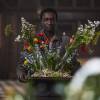Annika Season 1 challenged mystery fans by using first-person narration to relate the crimes investigated by D.S. Annika Stradhed and the Marine Homicide Unit as well as the events in Annika’s life. This was an important nod to the series’ beginning as a BBC Radio 4 audio drama. Season 2 continues the fourth wall monologue tradition with Annika adding new literary references each episode that express her mood towards events in her personal life and occasionally regarding the case. While Annika relates a fairly succinct version of the literary reference, she often leaves out interesting background information or in some cases parts of the story in question. This series will illuminate the missing context.
Season 2 begins right where we left off, with Annika stepping outside of the restaurant immediately after revealing that Michael is Morgan’s biological father. Annika tells the audience about a book of hundreds of old Scottish ballads collected into a volume called "Child’s Ballads." She says a man named Mr. Child collected them. According to Annika, one of them is about a Norwegian woman who sleeps with a man who turns into a seal. They break up of course, but when he finds out he has a child he steals the child from the mother. Both the child and the father go to sea and they end up dying by gunfire.
The ballad, which is number 113 in Child’s collection, is officially titled “The Great Silkie of Skule Skerry” . Silkie (also often spelled selkie) is the name for this mythological shapeshifter . The folk ballad originates from the islands of Shetland and Orkney. Child recorded the words but he didn’t record the music notes. Otto Emmanuel Andersson, a Finnish musicologist, recorded the tune after hearing a traditional singer in Orkney sing the tune. The most popular instrumentation today is a more modern rendition written in 1954 by Jim Waters. Joan Baez recorded her version of the ballad simply called “Silkie” in 1961 and it’s been recorded and covered by several folk and rock artists since then.
There are two main versions of the ballad. Annika tells the version that originates from Orkney . R. Menzies Fergusson first published the Orkney version in 1883 as "The Grey Selchie of Sule Skerrie". Andersson’s lyrics to match his instrumentation were based on the version published in 1934.
Annika says that the relationship between the woman and the seal ended badly. There’s a little bit more to it than the whole “species don’t mix” thing. Both versions of the ballad include the shapeshifter predicting that the woman would end up marrying the man who will kill him and her child. The child is a boy in both versions and the selkie gives the woman a bag of gold in exchange for the boy. Andersson’s lyrics include a section which elaborates that the woman rejected a marriage proposal from the seal-man.
The ballad is a metaphor for the parent-child relationship in general and also shows Annika’s concern that Morgan growing closer to Michael may mean the end of their close mother-daughter relationship. Annika so far hasn’t allowed Michael to be too involved in Morgan’s life, but after the hijacking at the end of Season 1, Annika has to make provisions in case she does die in the line of duty. Michael agrees, but he doesn’t offer Annika a bag of gold. He does offer Morgan the opportunity to make some extra money babysitting his daughters. She doesn’t know the girls are her half sisters, but they’re starting to bond anyway after Morgan was picked up by Michael’s wife Astrid when Annika and Michael were called away for work. By the end of the episode Annika realizes that Michael should know about Morgan, but Astrid interrupts one of her chances to tell him.
Unfortunately, the ballad does very little to illuminate the details of the investigation. The murder turns out to be driven by antisocial revenge, not selkie hunting. There was a bag of counterfeit currency to lure the suspect to arrest, but that’s the only thing linking the ballad to the rest of the work of the Marine Homicide Unit this week.
When, if ever, will Michael be told the truth? What novel or poem will be referenced next? We’ll find out next week on Annika!





